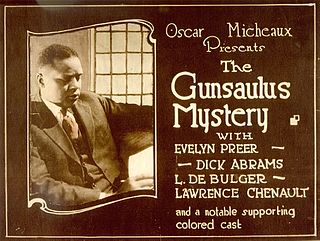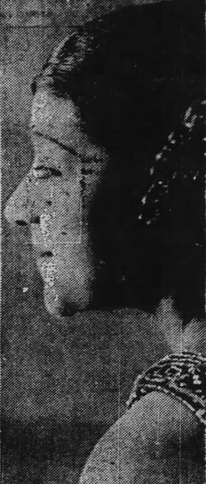Related Research Articles

Within Our Gates is a 1920 American silent film by the director Oscar Micheaux that portrays the contemporary racial situation in the United States during the early twentieth century, the years of Jim Crow, the revival of the Ku Klux Klan, the Great Migration of blacks to cities of the North and Midwest, and the emergence of the "New Negro". It was part of a genre called race films.

Oscar Devereaux Micheaux (; was an American author, film director and independent producer of more than 44 films. Although the short-lived Lincoln Motion Picture Company was the first movie company owned and controlled by black filmmakers, Micheaux is regarded as the first major African-American feature filmmaker, a prominent producer of race films, and has been described as "the most successful African-American filmmaker of the first half of the 20th century". He produced both silent films and sound films.

Body and Soul is a 1925 race film produced, written, directed, and distributed by Oscar Micheaux and starring Paul Robeson in his motion picture debut. In 2019, the film was selected by the Library of Congress for inclusion in the National Film Registry for being "culturally, historically, or aesthetically significant".

Evelyn Preer, was a pioneering American stage and screen actress and jazz and blues singer of the 1910s through the early 1930s. Preer was known within the black community as "The First Lady of the Screen."

The race film or race movie was a genre of film produced in the United States between about 1915 and the early 1950s, consisting of films produced for black audiences, and featuring black casts. Approximately five hundred race films were produced. Of these, fewer than one hundred remain. Because race films were produced outside the Hollywood studio system, they were largely forgotten by mainstream film historians until they resurfaced in the 1980s on the BET cable network. In their day, race films were very popular among African-American theatergoers. Their influence continues to be felt in cinema and television marketed to African Americans.

The Homesteader (1919) is a lost black-and-white silent film by African-American author and filmmaker Oscar Micheaux. The film is based on his novel inspired by his experiences.
Midnight Ramble is a 1994 documentary about the early history of Black American movies from the period between 1910 and 1950. Known as "race movies", these films, traditionally independent of Hollywood, were made primarily by, for and about the black community. This documentary is a tribute to a film genre that lasted for more than 40 years, produced over 500 movies, and created a foundation for contemporary films from directors such as Spike Lee and Tyler Perry. James Avery narrates this exploration of the early black film industry. There is a mistaken assumption that "race films" began largely in reaction to D. W. Griffith's 1915 The Birth of a Nation. Nothing could be further from the truth. Race movies actually began around 1910 in Chicago in response to the Black Community longing to see themselves reflected on the silver screen via this new medium of film. Wanting to see themselves through their own eyes, on their own terms thus counteracting the Hollywood stereotypes within the American media. The film focuses especially on the work of Oscar Micheaux, considered the "Dean of Black American film", a controversial filmmaker who wrote, produced, and directed over 40 features, and tackled difficult social issues in Black America. It includes clips from films by a number of African-American directors of the period, which is very helpful since many of these films are difficult to find or unavailable. There are two versions of the title of the documentary, both referring to the same work. Initially released in 1994 as, Midnight Ramble: Oscar Micheaux & the Story of Race Movies It was re-released as Midnight Ramble: The Story of the Black Film Industry by PBS in 1995 The 1995 version also eliminates the David McCullugh introduction.
Gertrude Sanborn was an American journalist, short story writer, and novelist.

Lawrence Chenault was an American vaudeville performer and silent film actor. He appeared in approximately 24 films between years 1920 and 1934; most of his performances were in films directed by pioneering African-American filmmaker Oscar Micheaux. His brother, Jack Chenault, was also a film actor.

The Gunsaulus Mystery is a 1921 American silent race film directed, produced, and written by Oscar Micheaux. The film was inspired by events and figures in the 1913-1915 trial of Leo Frank for the murder of Mary Phagan. The film is now believed to be lost. Micheaux remade the film 1935 as Murder in Harlem.

The Brute is a 1920 silent race film directed, written, produced and distributed by Oscar Micheaux. No print of the film is known to exist and the production is believed to be a lost film. The original version of the film included a scene where the boxer defeats a white rival, but Micheaux was forced to remove the scene by censors.
Deceit is a 1923 American silent black-and-white film. It is a conventional melodrama directed by Oscar Micheaux. Like many of Micheaux's films, Deceit casts clerics in a negative light. Although the film was shot in 1921, it was not released until 1923. It is not known whether the film currently survives, which suggests that it is a lost film.
Pearl Bowser is an author, collector, television director, film scholar, film director, producer, filmmaker, independent distributor and film archivist. Along with her peers Mel Roman and Charles Hobson, Bowser researched and curated “The Black Film” retrospective at the Jewish Museum in 1970. This prompted a new wave of public interest into “exhibiting, producing, and engaging with African American cinema beyond borders”. Most of her exalted career was spent traveling the globe in order to cultivate audiences for marginalized filmmakers. An example of her efforts, and also her most groundbreaking work, manifested in her research on “early-1900s Black film pioneer Oscar Micheaux”. This research can be seen in her book on the first ten years of the career of Oscar Micheaux, an African-American who directed 40 "race pictures" between 1918 and 1940. She is thus credited for having helped rediscover some of Oscar Micheaux's rare surviving films. She is the founder of African Diaspora Images, a collection of visual and oral histories that documents the history of African-American filmmaking. Part of her journey includes teaching young people film in the 1960s and 1970s.
The Broken Violin is an American silent film directed by Oscar Micheaux, released in 1928.
Andrew S. Bishop (1894–1959) was an actor on stage and screen. He and Cleo Desmond drew adoring fans to their theatrical performances. He starred in several of Oscar Michaux's African American films.
Ten Nights in a Barroom is an American film released in 1926. The film had a temperance theme and an African American cast. It followed on Timothy Shay Arthur's 1854 novel Ten Nights in a Bar-Room and What I Saw There and William W. Pratt's play, as well as earlier film adaptations albeit with white casts. A man's drinking causes him to lose money, his business, and his daughter. The film has been restored and is archived at the Library of Congress. Charles Gilpin stars. The film was released during the Prohibition era. Roy Calnek directed.
Harry Henderson was an actor in theater and films in the United States. He made four films with the Colored Players Film Corporation. He was also cast in several Oscar Micheaux films and had a starring role in the film melodrama The Scar of Shame. He portrays a wealthy concert pianist in the film. He also had a lead role in the 1926 film The Prince of His Race.
The Midnight Ace is a 1928 American crime film. Abe DeComathiere, Mabel Kelly and Oscar Roy Dugas starred. The film was directed by John H. Wade for Swan Micheaux's Dunbar Film Company. Swan Micheaux was Oscar Micheaux's brother. Swan had worked for Oscar before a failling out over his management of finances. Swan left and formed the Dunbar film company but it only made this film.

Henrietta L. Loveless, sometimes spelled Henrietta Lovelass or Henrietta Lovelace, was an American actress and singer. After graduating with a degree in music from Fisk University, Loveless acted in several films and numerous theatre shows during the 1920s and early 1930s. The latter half of the 1930s saw her move to exclusively vocal performances, including as a part of a harmony group at the 1939 New York World's Fair and in her own musical radio broadcast.
His Great Chance is a 1923 film directed by Ben Strasser. It is a 5-reel feature film The film starred Tim Moore as well as Gertie Brown. It is a lost film. A comedy, Leigh Whipper wrote it was the best of the African American films he had seen. D. Ireland Thomas was less favorable and blamed poor direction for a missed opportunity. Theater owner and producer W. S. Scales of Winston-Salem, North Carolina also produced The Devil's Match in 1923 for his North State Films company.
References
- ↑ Musser, Charles; Gaines, Jane Marie; Bowser, Pearl (March 28, 2016). Oscar Micheaux and His Circle: African-American Filmmaking and Race Cinema of the Silent Era. Indiana University Press. ISBN 9780253021557 – via Google Books.
- ↑ "The Girl from Chicago". The Criterion Channel.
- ↑ "Spider's Web, the (1926) - 01". The New York Age. January 8, 1927. p. 6.
- ↑ Stewart, Jacqueline Najuma (March 28, 2005). Migrating to the Movies: Cinema and Black Urban Modernity. University of California Press. ISBN 9780520936409 – via Google Books.
- ↑ "The Crisis". April 1979.
- ↑ "Entertainment-Jan-29-1927-1816312 | NewspaperArchive®".
- ↑ Musser, Charles; Gaines, Jane Marie; Bowser, Pearl (March 28, 2016). Oscar Micheaux and His Circle: African-American Filmmaking and Race Cinema of the Silent Era. ISBN 9780253021557.
- ↑ Institute, American Film; Afi, American Film (1997). Within Our Gates: Ethnicity in American Feature Films, 1911-1960. ISBN 9780520209640.
{{cite book}}: Missing|author1=(help)